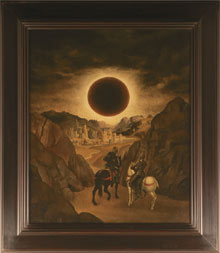
Detail, Laurent Grasso's Studies into the Past -- Eclipse, 2012 |
One of the unsettling things about America today is how more and more people seem to think that evolution, global warming and math are matters of faith rather than evidence. I couldn't help thinking of this growing notion that science is just a matter of personal preference when I visited "In the Holocene" at MIT's List Visual Arts Center.Curator João Ribas rounds up 46 artists who use "art as speculative science . . . an investigative and experimental activity, addressing or amending what is explained through traditional scientific means."
Primarily, the show is art inspired by natural phenomena. Laurent Grasso's 2012 handsome faux-early-Renaissance painting depicts two armored knights on horseback gazing at a solar eclipse. Matthew Buckingham's 2009 chalkboard is labeled with how long the light hitting it from the lamp above has traveled (".1027 seconds"). Trevor Paglen's 2012 photo of lots of concentric curves depicts, according to a sign, telecommunications satellites orbiting the Earth. On Kawara's 2009 audio recording One Million Years (Past and Future) broadcasts people reciting numbers: "35,964, 35,965, 35,966. . . . "
Last year's List Hans Haacke show invigoratingly explored similar territory, but this feels like walking into an esoteric Tumblr image collection, annotated by Ribas. Too much of the work offers dull aesthetics and blah ideas. Ribas's premise doesn't gel, perhaps because he's smarter than the art.
For example, Jimmie Durham's 2002 video shows an old refrigerator with someone off screen throwing stones at it — clang! The art world has sometimes interpreted Durham's "rock" performances as a meditation on Stone Age tools versus contemporary machines. "While these acts employ stone as a tool," Ribas's sign explains, "they also investigate the qualities of the stone, and how the relationship between the stone and the object it changes is only different in degree from our relationship to the stone itself." Maybe we're trying to wring too much meaning from the joke of a guy hucking rocks at an old appliance?
This whole science-y art stuff comes out of focusing on process rather than end product, a lineage running back through 1950s New York action painting and 1960s conceptualism. It's often been a fruitful misunderstanding of science to think that "experimentation" is the goal rather than a means to figure something out. But the art here has minor concerns, so I get hung up on definitions. Rather than pretending it's related to science, let's call it alchemy or shamanism or comedy.
>> GREGCOOKLAND.COM/JOURNAL
IN THE HOLOCENE :: MIT List Visual Arts Center, 20 Ames St, Cambridge :: Through January 6 :: 617.253.4680 orlistart.mit.edu